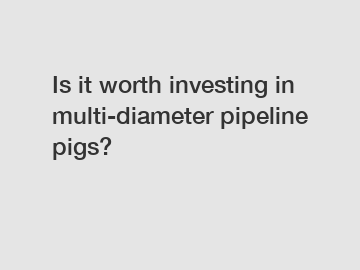Is it worth investing in multi-diameter pipeline pigs?
For those in the oil and gas industry, the question of whether or not to invest in multi-diameter pipeline pigs is one that often comes up. Pipeline pigs are tools that are used to clean, inspect, and maintain pipelines, and multi-diameter pigs are able to navigate through pipelines of varying sizes. But, are these pigs worth the investment? Let's explore the benefits and drawbacks of multi-diameter pigs to help you make an informed decision.
First and foremost, one of the biggest advantages of multi-diameter pigs is their versatility. With the ability to navigate through pipelines of different sizes, these pigs can be used in a wide range of applications. This means that you can use the same pig for multiple pipelines, reducing the need to purchase multiple pigs for different projects. This not only saves money, but also reduces the logistical hassle of having to switch out pigs for different jobs.
Additionally, multi-diameter pigs are often more efficient than single-diameter pigs. Because they can conform to the size of the pipeline they are traveling through, they are able to clean and inspect the pipeline more thoroughly. This can help to reduce the risk of corrosion and other issues that can arise from buildup in the pipeline. In the long run, this can save you money on costly repairs and maintenance.

Another benefit of multi-diameter pigs is their ability to provide more accurate data during inspections. By being able to travel through pipelines of varying sizes, these pigs can provide a more comprehensive view of the condition of the pipeline. This can help you to identify potential issues before they become major problems, allowing you to take proactive measures to address them.
Of course, there are some drawbacks to investing in multi-diameter pipeline pigs as well. One of the main considerations is cost. Multi-diameter pigs tend to be more expensive than single-diameter pigs, so you will need to weigh the cost of the investment against the potential benefits. However, as mentioned earlier, the versatility and efficiency of multi-diameter pigs can help to offset this cost over time.
Another potential drawback is the learning curve associated with using multi-diameter pigs. Because they need to be adjusted for different pipeline sizes, there may be a bit of a learning curve for operators who are used to working with single-diameter pigs. However, with proper training and practice, this issue can be overcome.
In conclusion, the decision of whether or not to invest in multi-diameter pipeline pigs ultimately depends on your specific needs and budget. If you work in an industry where you frequently encounter pipelines of varying sizes, the versatility and efficiency of multi-diameter pigs may make them a worthwhile investment. However, if you primarily work with pipelines of the same size, it may not be necessary to spend the extra money on multi-diameter pigs.
Ultimately, it is important to weigh the pros and cons of multi-diameter pigs and consider how they align with your business goals. By carefully evaluating your needs and budget, you can make an informed decision about whether or not to invest in these versatile pipeline pigs. If you do decide to make the investment, be sure to provide proper training for your operators to ensure that they are able to utilize the pigs to their fullest potential. By doing so, you can maximize the benefits of multi-diameter pigs and help to ensure the long-term integrity of your pipelines.
If you are looking for more details, kindly visit pipe flange manufacturers, weld pl, flange insulating joint.
156
0
0


Comments
All Comments (0)